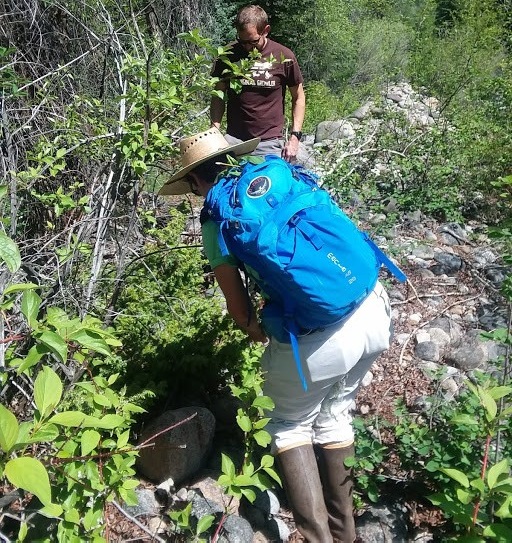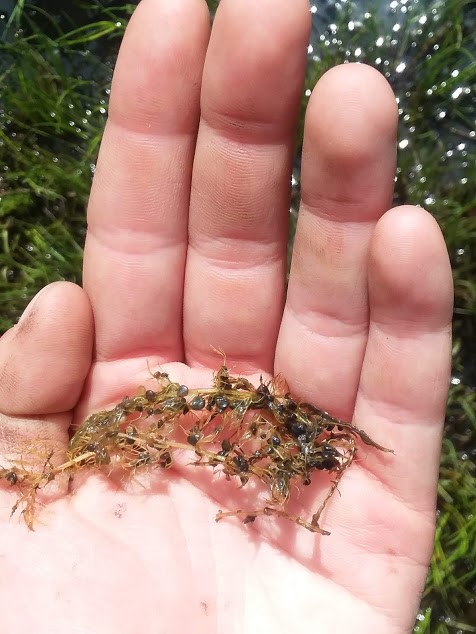By: Alex Binkley
(CNHP Siegele Conservation Science Intern)
It had been an exciting day. We were conducting a Bio Blitz at the Aspen Center for Environmental Studies (ACES), and on a tiny 25-acre natural space we had found over 60 plant species in the first few hours. I was loving the process because I had been allowed (and even encouraged) to ask questions about the plant species we were seeing, and I had asked A LOT of questions. My mentors, Sarah Marshall and Denise Culver were more than just patient with me, they were just as excited as I was!

Denise Culver (Senior Ecologist at CNHP) and Adam McCurdy (Forest Programs Director at ACES) exhibiting the proper methodology for walking a botany mile.
In all honesty, by midafternoon I had reached the point of mental saturation where I couldn’t take in any more information, but I was having so much fun learning about species I had wondered about for years that I continued asking anyway. We approached a beaver pond that had lots of little plants and freshwater shrimp in it and I couldn’t resist trying to learn a little more about it. How many chances would I ever get to ask two expert botanists about native aquatic plants?
I reached down and pulled up the first plant I saw, and asked Denise what it was. She looked up after glancing at the stringy plant in my hand, excited and wide-eyed. It was lesser bladderwort, Utricularia minor, one of only a handful of carnivorous plants in Colorado and a rare species CNHP tracks!

Utricularia minor creates negative pressure in their bladders (the tiny black pods on the plant above) and when a water flea (or any other aquatic creature small enough) swims by, it triggers the pod, and the flea is sucked in.
It was really exciting to find a rare plant on the first day of the Bio Blitz, it made the Bio Blitz feel like a treasure hunt! It made me want to keep asking about every new plant, even if it turned out to be a common invasive plant I hadn’t noticed before.
This was the clearest example of the lessons I learned about botany and the value of curiosity this summer. I’ve always been curious and asked a lot of questions, but frequently under-paid teachers and over-worked professors don’t have the time to answer my questions or point me in the right direction to answer my own questions.
Botany, on the other hand seems like it’s entirely question based. How much and what kind of hair is on the underside of the leaf? How much soil saturation can this plant tolerate? How did this plant get here? What is it called? Can I eat this?
Unlike math or physics, botany (and biology as a whole) is fluid. For every rule there is an exception. Because of the amount of individual variation among plants, and because there are so many different species to learn about, it is always OK to be wrong and always OK to ask questions.
Before this summer, I thought I liked wildlife better than plants. I knew I liked gardening, and learning about plants, but I didn’t realize this was a potential career path for me. After a few weeks of helping with riparian surveys and a few Bio Blitzes, I joked about Denise, Pam, Sarah, and Dave “converting me,” but in all seriousness, my experiences this summer have made me reconsider field work, botany, and my path forward.
Thank you again to my mentors at CNHP, and everyone who helped to make this summer happen! I will always be grateful for this experience.
Thank you for reading about one of my adventures this summer!

(Left to right): Alex Binkley, Emma Balunek, Griselda Landa-Posas, Elena Gratton. Me and three of my fellow interns celebrating a successful Bio Blitz (and procrastinating going home).




